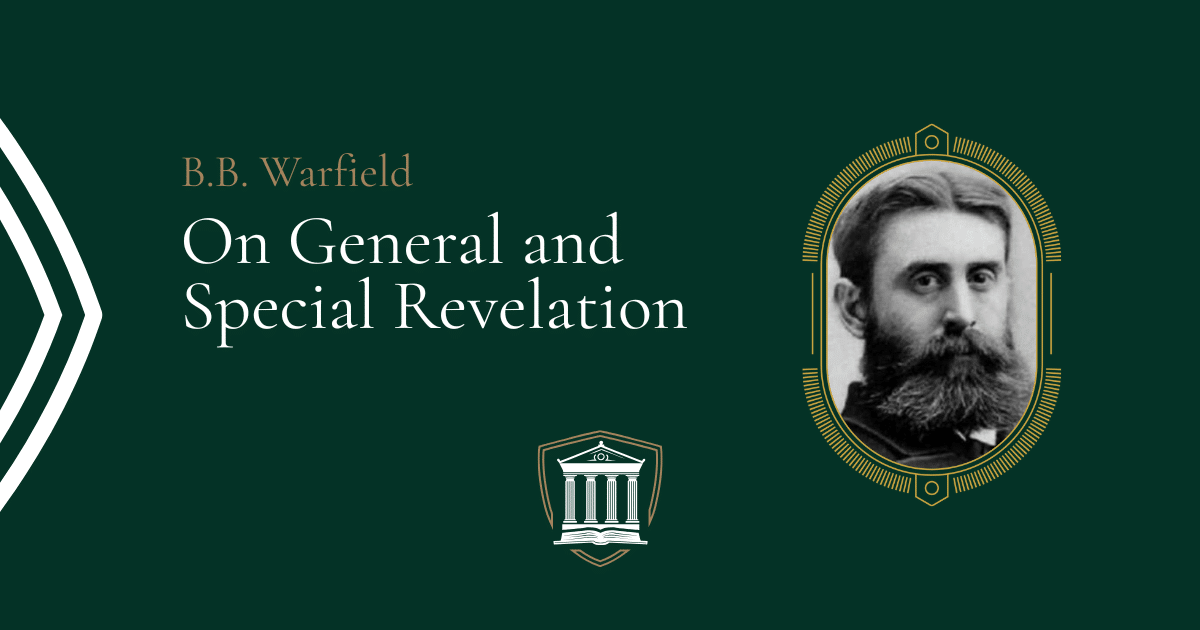One of the most well-known works of Reformed Theology published in the twentieth century is B. B. Warfield’s The Inspiration and Authority of the Bible.1 Originally printed in 1948, this work is a posthumous compilation of his most important articles on the doctrine of Scripture for future generations to study and learn from one of Old Princeton’s final theologians.
B. B. Warfield (1851–1921) expounded Reformed Theology within an American context dominated by D. L. Moody-style evangelical revivalism leading up to the Fundamentalist-Modernist controversies of the 1920s and 1930s. His articulations and biblical expositions of the inspiration and infallibility of Scripture provided neo-evangelicals with the intellectual equipment to solidify a conservative articulation of the inerrancy of Scripture in the 1970s. Truly, Fred Zaspel is correct when he observes that virtually all treatments of the doctrine of inspiration by Reformed and evangelical theologians since “are essentially a restatement of Warfield.”2
A student of Princeton in its final years, Cornelius Van Til, the Godfather of biblical counseling, studied the theology of Old Princeton under the tutelage of Warfield’s successor, C. W. Hodge (grandson of Princeton theologian, A. A. Hodge).3 Therefore, it is not surprising to see inferences and references to Warfield’s publications, including Warfield’s writings on Scripture and inspiration, throughout the annotated notes of Van Til’s An Introduction to Systematic Theology.4 Reformed biblical counselors should therefore consider Warfield’s reflections upon the relationship between the doctrines of general and special revelation in the selection entitled “The Nature of Revelation” within The Inspiration and Authority of the Bible.
The Nature of Revelation
Within the opening pages of this article, Warfield draws some helpful distinctions between the nature, content, and purposes of both general and special revelation. General revelation is defined as “the revelation which God continuously makes to all men: by it his power and divinity are made known.”5 Special revelation is “the revelation which [God] makes exclusively known to his chosen people: through it his saving grace is made known” (5). Warfield references the organic relationship between general and special revelation within the logical flow of Psalm 19. In Psalm 19:1, 4, the Psalmist observes God’s general revelation in creation as the heavens declare the glory of God: “their line has gone out through all the earth” (5). In Psalm 19:7 the Psalmist focuses upon the revelation of God in the Scriptures: “The law of Jehovah is perfect, restoring the soul” (5).
There is a defining characteristic in Warfield’s mind concerning the differences between general and special revelation. After quoting Lord Francis Bacon—a favorite theistic philosopher to quote within the American Presbyterian tradition on the sciences6—Warfield argues that general revelation is adapted to “man as man” while special revelation is adapted to “man as sinner” (5). Essentially, Warfield is identifying the progressive nature of God’s revelation to man. Within the garden, Adam encountered a world rich with beauty, pleasure, and knowledge for him to explore as God’s covenant creature. Originally, there were no obstacles hindering man’s exploration and enjoyment of God’s creation as man communed with his Creator (6).
After the Fall in Genesis 3, man needed a new message that would not be communicated through God’s general revelation in creation. Man now needed a message of grace, a message of salvation. Significantly, man also needed a message of special revelation that would restore to him the ability to discern rightly the divine truths communicated to mankind through the world around him. Warfield summarizes this point when he writes:
[Man], on becoming sinner, has not ceased to be man, but has only acquired new needs requiring additional provisions to bring him to the end of his existence, so the revelation directed to man as sinner does not supersede that given to man as man, but supplements it with these new provisions for his attainment, in his new condition of blindness, helplessness, and guilt induced by sin, of the end of his being. . . . On the entrance of sin into the world, destroying this communion with God and obscuring the knowledge of him derived from nature, another mode of revelation was necessitated, having also another content, adapted to the new revelation to God and the new conditions of intellect, heart, and will brought about by sin. (5–6)
This section reveals the organic and supplemental nature of general and special revelation. General revelation is knowledge within the creation order that bears witness to God’s existence through the things that are made in their order, beauty, and goodness. “And not being a sinner, man in Eden, as he contemplated the works of God, saw God in the unclouded mirror of his mind with a clarity of vision, and lived with him in the untroubled depths of his heart with a trustful intimacy of association, inconceivable to sinners” (7). Special revelation originally was God’s verbal and “immediate” communion with Adam and Eve in the garden (7), but special revelation gained a redemptive and a restorative element once man had fallen into sin. Therefore, special revelation throughout Scripture is redemptive in communicating to man the message of grace, while also restorative in allowing man to achieve the “end of his being” by providing him with the ability to discover God and his wisdom and power in the things he has made. As Cornelius Van Til summarizes,
In consequence of his sin, then, man needs both new or additional revelation—a revelation of grace—and a renewed power by which to perceive that new revelation and to understand and accept the revelation of God in nature for what it really is. He needs, as Warfield has put it, both new light and new power of sight.7
In the rest of this section, Warfield labors to describe the various nuances in the relationship between general and special revelation as he presents two complementary visions of general and special revelation. A biblical view of general and special revelation maintains that both general and special revelation are (1) distinct from one another and (2) complementary and incomplete without the other.
The Differences between General and Special Revelation
According to Warfield, both general and special revelation are different in “nature, reach, and purpose” (6). The following quotes outline how Warfield parses the differences between these two forms of revelation:
- General revelation is natural; special revelation is supernatural. General revelation is “communicated through the media of natural phenomena, occurring in the course of nature or of history” (6). Special revelation “implies an intervention in the natural course of things and is not merely in source but in mode supernatural” (6).
- General revelation is addressed and accessible to men; special revelation is addressed to sinners. “The one is addressed generally to all intelligent creatures, and is therefore accessible to all men; the other is addressed to a special class of sinners, to whom God would make known his salvation” (6).
- General revelation and special revelation are ordained to meet different needs. General revelation meets the natural need of man’s knowledge of their God as Creator. Special revelation meets man’s need as a sinner to “rescue broken and deformed sinners from their sin and its consequences” (6).
The Organic Relationship between General and Special Revelation
Despite their differences, general and special revelation are inescapably dependent upon one another and supplement one another as a unified system of God’s revelation to man. Even as we distinguish between the nature and purposes of general revelation and special revelation, Warfield warns that Christians cannot forget that only “by their cooperation is the effect produced” (7).
The easiest way to understand this point is to consider the significance of special revelation for general revelation. Because of the Fall, man is unable to interpret the world correctly and yet stands under condemnation of general revelation’s testimony to the existence of God (Rom 1:20)—an unfortunate predicament for fallen man! Therefore, special revelation restores to man the ability to discern the natural truths of God within the creation order, as seen in the perennial image of Scripture as a pair of “glasses” or “spectacles.”8
Nevertheless, Christians may ask, “How is special revelation dependent upon general revelation?” Critically, Warfield concludes that the natural knowledge of God within the creation order—“as the mighty and wise, righteous and good maker and ruler of all things” (7)—is so significant for man that the further revelation of God’s salvation of sinners “could not be either intelligible, credible, or operative” without it (7). God’s general revelation provides the epistemological context upon which the good news of God’s saving grace in Christ stands. The incarnate Word, who offers salvation to fallen mankind (John 1:1, 17), is the same eternal Word who holds all things together (Heb 1:3).
Conclusion
Warfield’s reflections upon the relationship between general and special revelation are both theologically insightful and doxologically stirring. Everywhere man looks within creation—from the farthest star and galaxy to the smallest atom—declares the glory of God. This revelation is addressed to all men and naturally accessible to their intellectual abilities as man fulfills his calling as a prophet to study and interpret the environment around him. After the Fall, special revelation contains the message of grace, providing fallen sinners with new light to interpret creation rightly and new power of sight to see the world as God’s sovereignly ordained environment through regeneration. May these nuances aid Reformed biblical counselors as they seek to discern God’s will for their counselees through reflecting upon God’s revelation in creation and in the Scriptures.
- B. B. Warfield, The Inspiration and Authority of the Bible, ed. John J. Hughes, rev. ed. (Phillipsburg, NJ: P&R, 2023) ↩︎
- Fred G. Zaspel, The Theology of B. B. Warfield: A Systematic Summary (Wheaton, IL: Crossway, 2010), 574. ↩︎
- John Muether, Cornelius Van Til: Reformed Apologist and Churchman, American Reformed Biographies (Phillipsburg, NJ: P&R, 2007), 52–58. ↩︎
- See Cornelius Van Til, An Introduction to Systematic Theology, ed. William Edgar, 2nd ed. (Phillipsburg, NJ: P&R, 2007), 204n35, 216n69. ↩︎
- Warfield, The Inspiration and Authority of the Bible, 5. All subsequent citations from this work will appear in parentheses. ↩︎
- Here is the quote in full: “The heavens indeed tell of the glory of God, but not of his will according to which the poet prays to be pardoned and sanctified” (5). ↩︎
- See Cornelius Van Til, An Introduction to Systematic Theology, ed. William Edgar, 2nd ed. (Phillipsburg, NJ: P&R, 2007), 193. ↩︎
- See John Calvin, Institutes of the Christian Religion, ed. John T. McNeill, trans. Ford Lewis Battles (Louisville: Westminster John Knox Press, 2006), I.VI.1. ↩︎

